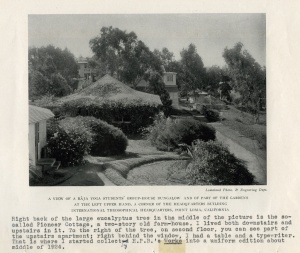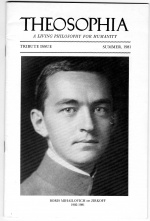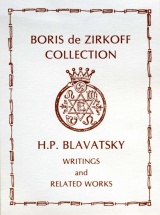Boris de Zirkoff: Difference between revisions
No edit summary |
No edit summary |
||
| Line 1: | Line 1: | ||
'''Boris de Zirkoff''' (1902–1981) was a relative of [[H. P. Blavatsky]] and the editor of her written works. He lived for many years in the [[Point Loma]] community, where he created and edited the periodical [[Theosophia (periodical)|''Theosophia'']]. | '''Boris de Zirkoff''' (1902–1981) was a relative of [[H. P. Blavatsky]] and the editor of her written works. He lived for many years in the [[Point Loma]] community, where he created and edited the periodical [[Theosophia (periodical)|''Theosophia'']]. | ||
== Early years == | == Early years == | ||
De Zirkoff was born in Petrograd, Russia <nowiki>[</nowiki>now known as Saint Petersburg<nowiki>]</nowiki> on [[March 7]], 1902. His mother was Lydia Dmitriyevna von Hahn.<ref>"Zirkoff, Boris de". ''Theosophical Encyclopedia''. Quezon City, Philippines: Theosophical Publishing Company, 2006. 688-689. Available at [http://theosophy.ph/encyclo/index.php?title=Zirkoff,_Boris_de Theosopedia],</ref> who was a second cousin to [[Helena Petrovna Blavatsky]]. His father was Mihail Vassilyevich de Zirkoff, a general in the Russian Imperial Army.<ref>John Cooper. "Last Link with H. P. Blavatsky Broken: Death of Boris de Zirkoff (1902-1981)." ''Theosophy in Australia'' 45.2 (June 1981): 232-233.</ref> | De Zirkoff was born in Petrograd, Russia <nowiki>[</nowiki>now known as Saint Petersburg<nowiki>]</nowiki> on [[March 7]], 1902. His mother was Lydia Dmitriyevna von Hahn.<ref>"Zirkoff, Boris de". ''Theosophical Encyclopedia''. Quezon City, Philippines: Theosophical Publishing Company, 2006. 688-689. Available at [http://theosophy.ph/encyclo/index.php?title=Zirkoff,_Boris_de Theosopedia],</ref> who was a second cousin to [[Helena Petrovna Blavatsky]]. His father was Mihail Vassilyevich de Zirkoff, a general in the Russian Imperial Army.<ref>John Cooper. "Last Link with H. P. Blavatsky Broken: Death of Boris de Zirkoff (1902-1981)." ''Theosophy in Australia'' 45.2 (June 1981): 232-233.</ref> According to a friend, scholar W. Y. Evans-Wentz, de Zirkoff was "in his own right a Baron."<ref>Letter from W. Y. Evans-Wentz. ''Theosophia'' Tribute Issue 37.4 (Summer 1981): 4.</ref> Boris described his family relationship to [[Helena Petrovna Blavatsky]] in this way: | ||
<blockquote> | <blockquote> | ||
| Line 14: | Line 9: | ||
</blockquote> | </blockquote> | ||
Modern genealogists would call this relationship "second cousin once removed." | Modern genealogists would call this relationship "second cousin once removed." | ||
Young Boris was tutored at home. He had an aptitude for languages, eventually mastering Russian, English, Swedish, German, and French, as well as the classics. As a boy in Russia, Boris was aware of his famous relative, but knew little of her. | Young Boris was tutored at home. He had an aptitude for languages, eventually mastering Russian, English, Swedish, German, and French, as well as the classics. As a boy in Russia, Boris was aware of his famous relative, but knew little of her. | ||
Turmoil | Turmoil during the Russian Revolution in 1917 forced Boris to flee with his mother and stepfather across Finland. After settling in Sweden, he discovered ''The Secret Doctrine''. According to one account, he found a Swedish translation in a library,<ref>John Cooper. "Last Link with H. P. Blavatsky Broken: Death of Boris de Zirkoff (1902-1981)." ''Theosophy in Australia'' 45.2 (June 1981): 232-233.</ref> but another version of the story tells that he first saw HPB's masterwork in the home of the Russian Consul.<ref>"Zirkoff, Boris de". ''Theosophical Encyclopedia''. Quezon City, Philippines: Theosophical Publishing Company, 2006. 688-689. Available at [http://theosophy.ph/encyclo/index.php?title=Zirkoff,_Boris_de Theosopedia],</ref> The [[Theosophical Movement]] was well established in Sweden at that time. De Zirkoff met [[Katherine Tingley]] during one of her European tours as head of the [[Universal Brotherhood and Theosophical Society]], and she invited him to live at [[Point Loma]] in California. | ||
[[File:BdeZ life at Point Loma.jpg|300px|right|thumb|Notes typed by B de Z on a photograph show where he worked at Point Loma. Image from TSA Archives.]] | [[File:BdeZ life at Point Loma.jpg|300px|right|thumb|Notes typed by B de Z on a photograph show where he worked at Point Loma. Image from TSA Archives.]] | ||
| Line 43: | Line 38: | ||
<br> | <br> | ||
Excerpts from Blavatsky's writings were frequently featured. The best writers from all the Theosophical traditions had articles printed on its pages. Some well-known authors were [[William Quan Judge]], [[Henry Steel Olcott]], [[Gottfried de Purucker]], [[Mary K. Neff]], [[Sven Eek]], [[Ernest Wood]], [[Henry T. Edge]], [[Charles Johnston]], [[Josephine Ransom]], [[Manly P. Hall]], [[L. Gordon Plummer]], [[Herbert Coryn]], [[George William Russell]] writing as AE, and [[Julia Keightley]] writing as Jasper Niemand. Harold W. Dempster and Arthur L. Joquel were among the most frequent contributors. | Excerpts from Blavatsky's writings were frequently featured. The best writers from all the Theosophical traditions had articles printed on its pages. Some well-known authors were [[William Quan Judge]], [[Henry Steel Olcott]], [[Gottfried de Purucker]], [[Mary K. Neff]], [[Sven Eek]], [[Ernest Wood]], [[Henry T. Edge]], [[Charles Johnston]], [[Josephine Ransom]], [[Manly P. Hall]], [[L. Gordon Plummer]], [[Herbert Coryn]], [[George William Russell]] writing as AE, and [[Julia Keightley]] writing as Jasper Niemand. Harold W. Dempster and Arthur L. Joquel were among the most frequent contributors. | ||
<br> | <br> | ||
<br> | <br> | ||
<br> | <br> | ||
== Collected Writings project == | |||
De Zirkoff's work received international recognition and cooperation from the major Theosophical organizations. In 1981 he was awarded the [[Subba Row Medal]] of the [[Theosophical Society (Adyar)]] to acknowledge his superb contributions to Theosophical literature. | De Zirkoff's work received international recognition and cooperation from the major Theosophical organizations. In 1981 he was awarded the [[Subba Row Medal]] of the [[Theosophical Society (Adyar)]] to acknowledge his superb contributions to Theosophical literature. | ||
== Other writings == | == Other writings == | ||
<br> | <br> | ||
<br> | <br> | ||
<br> | <br> | ||
== Lecturing == | |||
De Zirkoff was also a fine lecturer. In 1959 he toured Europe, speaking in Amsterdam, The Hague, and Utrecht.<ref>Letter from Lucie and Jan Molijn. ''Theosophia'' Tribute Issue 37.4 (Summer 1981): 12.</ref> | |||
His address at the [[Centenary Congress]], entitled "The Dream that Never Dies," was "truly a high point of that week-long gathering."<ref>Letter from Elwood and Alicia Schenck. ''Theosophia'' Tribute Issue 37.4 (Summer 1981): 9.</ref> | |||
== Later life == | |||
Early in 1981, the twelfth volume of the ''Collected Writings'' series was published, and the next two volumes were at the printer. [[Radha Burnier]], President of the [[Theosophical Society (Adyar)|Theosophical Society based in Adyar]] wrote to "Dear Brother Boris" on February 23rd: | |||
<blockquote> | |||
The members of the General Council and myself, unanimously considered you as the fittest person to receive the [[Subba Row Medal|Subba Row medal]] now. The work you have done in preparing the Collective writings of our great Founder, H.P. Blavatsky, is monumental. Every token of the appreciation that is felt in respect of your lifelong labour, appears to be inadequate. However, in grateful recognition of your untiring efforts during several decades, to make available to the world the wealth of knowledge contained in H. P. B.'s writings, I have the honour to request Miss Joy Mills to present to you, on behalf of the Society the Subba Row medal.<ref>Letter from Radha Burnier. ''Theosophia'' Tribute Issue 37.4 (Summer 1981): 27.</ref> | |||
</blockquote> | |||
Radha Burnier truly appreciated in the breadth and depth of scholarship that went into the ''Collected Writings'' project, since during the 1950s she had responded with patience and precision to hundreds of questions that he sent to the [[Adyar Library and Research Centre]] concerning Sanskrit and Tamil terms. Many other friends and coworkers wrote of Boris de Zirkoff | |||
when, after a long illness, he passed away on [[March 4]], 1981. A final issue of ''Theosophia'', the Tribute Issue, was filled with letters praising their friend's dedication, scholarship, and helpfulness, his wit, humor, and simple, undemanding lifestyle. Joy Mills quoted a letter Boris had written to her: | |||
<blockquote> | |||
The only thing I live for and work for is the perpetuation and dessemination of genuine Theosophy whether it be through the words of H. P. B. or those who have remained true to her message and the instructions of Those standing behind her.<ref>Letter from Joy Mils. ''Theosophia'' Tribute Issue 37.4 (Summer 1981): 24.</ref> | |||
</blockquote> | |||
== Archival legacy == | == Archival legacy == | ||
[[File:BdeZ book plate.jpg|160px|right|thumb|Book plate from library of Boris de Zirkoff]] | [[File:BdeZ book plate.jpg|160px|right|thumb|Book plate from library of Boris de Zirkoff]] | ||
| Line 61: | Line 74: | ||
<references/> | <references/> | ||
[[Category:Writers|Zirkoff, Boris | [[Category:Writers|de Zirkoff, Boris]] | ||
[[Category:TS Point Loma|Zirkoff, Boris | [[Category:TS Point Loma|de Zirkoff, Boris]] | ||
[[Category:Editors|Zirkoff, Boris | [[Category:Editors|de Zirkoff, Boris]] | ||
[[Category:Nationality Russian|Zirkoff, Boris | [[Category:Nationality Russian|de Zirkoff, Boris]] | ||
[[Category:Nationality Naturalized American|Zirkoff, Boris | [[Category:Nationality Naturalized American|de Zirkoff, Boris]] | ||
Revision as of 03:24, 4 September 2013
Boris de Zirkoff (1902–1981) was a relative of H. P. Blavatsky and the editor of her written works. He lived for many years in the Point Loma community, where he created and edited the periodical Theosophia.
Early years
De Zirkoff was born in Petrograd, Russia [now known as Saint Petersburg] on March 7, 1902. His mother was Lydia Dmitriyevna von Hahn.[1] who was a second cousin to Helena Petrovna Blavatsky. His father was Mihail Vassilyevich de Zirkoff, a general in the Russian Imperial Army.[2] According to a friend, scholar W. Y. Evans-Wentz, de Zirkoff was "in his own right a Baron."[3] Boris described his family relationship to Helena Petrovna Blavatsky in this way:
Her father and my grandfather (my mother's father) were cousins. There was a considerable diference in age between the two branches of the family; hence I was born after HPB had died. This makes me something like a grand-nephew of HPB.[4]
Modern genealogists would call this relationship "second cousin once removed."
Young Boris was tutored at home. He had an aptitude for languages, eventually mastering Russian, English, Swedish, German, and French, as well as the classics. As a boy in Russia, Boris was aware of his famous relative, but knew little of her.
Turmoil during the Russian Revolution in 1917 forced Boris to flee with his mother and stepfather across Finland. After settling in Sweden, he discovered The Secret Doctrine. According to one account, he found a Swedish translation in a library,[5] but another version of the story tells that he first saw HPB's masterwork in the home of the Russian Consul.[6] The Theosophical Movement was well established in Sweden at that time. De Zirkoff met Katherine Tingley during one of her European tours as head of the Universal Brotherhood and Theosophical Society, and she invited him to live at Point Loma in California.
Life at Point Loma
Late in 1923, the 21-year-old de Zirkoff left Sweden, where he was living in the home of Mrs. Wicander, to move to the Point Loma community. There he became acquainted with pupils of HPB including Dr. Henry T. Edge, Charles J. Ryan, Reginald Machell, and Dr. Herbert Coryn.
Editorship of Theosophia
.
Theosophia was an independent quarterly periodical published in Los Angeles from May-June 1944 to Summer 1981. The final issue, pictured here, was a tribute to the recently deceased editor.
Throughout its existence, the magazine maintained a neutral attitude toward the various Theosophical organizations, and a high standard of scholarship. Every issue began with an article by Boris de Zirkoff. Schedules of lectures were often listed for the Los Angeles and San Diego areas. Book reviews and transcriptions of radio lectures and interviews were occasionally included.
Excerpts from Blavatsky's writings were frequently featured. The best writers from all the Theosophical traditions had articles printed on its pages. Some well-known authors were William Quan Judge, Henry Steel Olcott, Gottfried de Purucker, Mary K. Neff, Sven Eek, Ernest Wood, Henry T. Edge, Charles Johnston, Josephine Ransom, Manly P. Hall, L. Gordon Plummer, Herbert Coryn, George William Russell writing as AE, and Julia Keightley writing as Jasper Niemand. Harold W. Dempster and Arthur L. Joquel were among the most frequent contributors.
Collected Writings project
De Zirkoff's work received international recognition and cooperation from the major Theosophical organizations. In 1981 he was awarded the Subba Row Medal of the Theosophical Society (Adyar) to acknowledge his superb contributions to Theosophical literature.
Other writings
Lecturing
De Zirkoff was also a fine lecturer. In 1959 he toured Europe, speaking in Amsterdam, The Hague, and Utrecht.[7] His address at the Centenary Congress, entitled "The Dream that Never Dies," was "truly a high point of that week-long gathering."[8]
Later life
Early in 1981, the twelfth volume of the Collected Writings series was published, and the next two volumes were at the printer. Radha Burnier, President of the Theosophical Society based in Adyar wrote to "Dear Brother Boris" on February 23rd:
The members of the General Council and myself, unanimously considered you as the fittest person to receive the Subba Row medal now. The work you have done in preparing the Collective writings of our great Founder, H.P. Blavatsky, is monumental. Every token of the appreciation that is felt in respect of your lifelong labour, appears to be inadequate. However, in grateful recognition of your untiring efforts during several decades, to make available to the world the wealth of knowledge contained in H. P. B.'s writings, I have the honour to request Miss Joy Mills to present to you, on behalf of the Society the Subba Row medal.[9]
Radha Burnier truly appreciated in the breadth and depth of scholarship that went into the Collected Writings project, since during the 1950s she had responded with patience and precision to hundreds of questions that he sent to the Adyar Library and Research Centre concerning Sanskrit and Tamil terms. Many other friends and coworkers wrote of Boris de Zirkoff when, after a long illness, he passed away on March 4, 1981. A final issue of Theosophia, the Tribute Issue, was filled with letters praising their friend's dedication, scholarship, and helpfulness, his wit, humor, and simple, undemanding lifestyle. Joy Mills quoted a letter Boris had written to her:
The only thing I live for and work for is the perpetuation and dessemination of genuine Theosophy whether it be through the words of H. P. B. or those who have remained true to her message and the instructions of Those standing behind her.[10]
Archival legacy
Boris de Zirkoff left his fine library to the Henry S. Olcott Memorial Library of the Theosophical Society in America, where it is held intact in the Rare Books Room. His papers, including his correspondence and research files used in his work on H. P Blavatsky's collected writings and her letters, are in the Archives Department.
Notes
- ↑ "Zirkoff, Boris de". Theosophical Encyclopedia. Quezon City, Philippines: Theosophical Publishing Company, 2006. 688-689. Available at Theosopedia,
- ↑ John Cooper. "Last Link with H. P. Blavatsky Broken: Death of Boris de Zirkoff (1902-1981)." Theosophy in Australia 45.2 (June 1981): 232-233.
- ↑ Letter from W. Y. Evans-Wentz. Theosophia Tribute Issue 37.4 (Summer 1981): 4.
- ↑ Letter to Gertrud Bäzner. July 30, 1969. Boris de Zirkoff Papers. Record Series 22. Theosophical Society in American Archives, Wheaton, Illinois.
- ↑ John Cooper. "Last Link with H. P. Blavatsky Broken: Death of Boris de Zirkoff (1902-1981)." Theosophy in Australia 45.2 (June 1981): 232-233.
- ↑ "Zirkoff, Boris de". Theosophical Encyclopedia. Quezon City, Philippines: Theosophical Publishing Company, 2006. 688-689. Available at Theosopedia,
- ↑ Letter from Lucie and Jan Molijn. Theosophia Tribute Issue 37.4 (Summer 1981): 12.
- ↑ Letter from Elwood and Alicia Schenck. Theosophia Tribute Issue 37.4 (Summer 1981): 9.
- ↑ Letter from Radha Burnier. Theosophia Tribute Issue 37.4 (Summer 1981): 27.
- ↑ Letter from Joy Mils. Theosophia Tribute Issue 37.4 (Summer 1981): 24.


